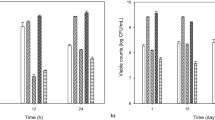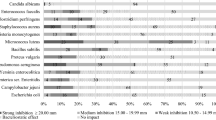Abstract
Fruit juices have shown promising results as new probiotic carriers. This study aimed to evaluate acerola, jelly palm, and passion fruit juices as substrates for fermentation using Lactiplantibacillus plantarum CCMA 0743 and Lacticaseibacillus paracasei LBC-81 in single and mixed cultures. First, the juices were evaluated as substrate and selected based on bacterial growth performance during fermentation. Afterward, the impact of fermentation on sugars, organic acids, and bioactive compounds was also appraised. Phytochemical modification of three different juices fermented by lactic acid bacteria at 37 °C/24 h was evaluated. After 18 h of fermentation, passion fruit juice showed higher cell viable counts of single and mixed L. plantarum CCMA 0743 culture, above 9.00 Log CFU/mL, and pH between 4.07 and 4.10. Sugars consumption and organic acid production were influenced by juice composition and culture used. The mixed culture reduced the total sugars in the passion fruit juice by approximately 53.0% (8.51 g/L). Lactic acid was the main product of the sugars fermentation, with higher concentrations detected in passion fruit juice (8.39–11.23 g/L). Bioactive compounds were analyzed on the selected substrate. The fermentative process reduced antioxidant activity and carotenoid content. However, single L. plantarum CCMA 0743 culture increased the yellow flavonoid content of passion fruit juice by approximately 3.0 µg/mL. L. plantarum CCMA 0743 showed high and suitable cell, viable counts, to claimed probiotic products, increasing bioactive compounds in passion fruit juice. Therefore, this strain and passion fruit substrate showed attractive potential to produce alternative and functional fermented fruit beverages.



Similar content being viewed by others
Availability of data and material
Not applicable.
Code availability
Not applicable.
References
Ogrodowczyk A, Drabińska N (2021) Crossroad of tradition and innovation — the application of lactic acid fermentation to increase the nutritional and health-promoting potential of plant-based food products—a review. Polish J Food Nutr Sci 71:107–134
Valero-Cases E, Cerdá-Bernad D, Pastor JJ, Frutos MJ (2020) Nondairy fermented beverages as potential carriers to ensure probiotics, prebiotics, and bioactive compounds arrival to the gut and their health benefits. Nutrients. https://doi.org/10.3390/nu12061666
Marsh AJ, Hill C, Ross RP, Cotter PD (2014) Fermented beverages with health-promoting potential: past and future perspectives. Trends Food Sci Technol 38:113–124
Pimentel TC, da Costa WKA, Barão CE, Rosset M, Magnani M (2021) Vegan probiotic products: a modern tendency or the newest challenge in functional foods. Food Res Int. https://doi.org/10.1016/j.foodres.2020.110033
Bhardwaj RL, Nandal U, Pal A, Jain S (2014) Bioactive compounds and medicinal properties of fruit juices. Fruits 69:391–412
Hashemi SMB, Jafarpour D (2020) Fermentation of bergamot juice with Lactobacillus plantarum strains in pure and mixed fermentations: chemical composition, antioxidant activity and sensorial properties. Lwt 131:109803
Ricci A, Cirlini M, Levante A, Dall’Asta C, Galaverna G, Lazzi C (2018) Volatile profile of elderberry juice: effect of lactic acid fermentation using L. plantarum, L. rhamnosus and L. casei strains. Food Res Int 105:412–422
Cirlini M, Ricci A, Galaverna G, Lazzi C (2020) Application of lactic acid fermentation to elderberry juice: changes in acidic and glucidic fractions. Lwt 118:108779
Kaprasob R, Kerdchoechuen O, Laohakunjit N, Sarkar D, Shetty K (2017) Fermentation-based biotransformation of bioactive phenolics and volatile compounds from cashew apple juice by select lactic acid bacteria. Process Biochem 59:141–149
Roberts D, Reyes V, Bonilla F, Dzandu B, Liu C, Chouljenko A, Sathivel S (2018) Viability of Lactobacillus plantarum NCIMB 8826 in fermented apple juice under simulated gastric and intestinal conditions. Lwt 97:144–150
Tripathi MK, Giri SK (2014) Probiotic functional foods: survival of probiotics during processing and storage. J Funct Foods 9:225–241
Zhao MN, Zhang F, Zhang L, Liu BJ, Meng XH (2019) Mixed fermentation of jujube juice (Ziziphus jujuba Mill.) with L. rhamnosus GG and L. plantarum-1: effects on the quality and stability. Int J Food Sci Technol 54:2624–2631
Espirito-Santo AP, Carlin F, Renard CMGC (2015) Apple, grape or orange juice: which one offers the best substrate for lactobacilli growth?—a screening study on bacteria viability, superoxide dismutase activity, folates production and hedonic characteristics. Food Res Int 78:352–360
Lizardo RCM, Cho HD, Won YS, Il SK (2020) Fermentation with mono- and mixed cultures of Lactobacillus plantarum and L. casei enhances the phytochemical content and biological activities of cherry silverberry (Elaeagnus multiflora Thunb.) fruit. J Sci Food Agric 100:3687–3696
Septembre-Malaterre A, Remize F, Poucheret P (2018) Fruits and vegetables, as a source of nutritional compounds and phytochemicals: changes in bioactive compounds during lactic fermentation. Food Res Int 104:86–99
Kwaw E, Ma Y, Tchabo W, Apaliya MT, Wu M, Sackey AS, Xiao L, Tahir HE (2018) Effect of Lactobacillus strains on phenolic profile, color attributes and antioxidant activities of lactic-acid-fermented mulberry juice. Food Chem 250:148–154
Gao H, Wen J-J, Hu J-L, Nie Q-X, Chen H-H, Nie S-P, Xiong T, Xie M-Y (2019) Momordica charantia juice with Lactobacillus plantarum fermentation: chemical composition, antioxidant properties and aroma profile. Food Biosci 29:62–72
Multari S, Carafa I, Barp L, Caruso M, Licciardello C, Larcher R, Tuohy K, Martens S (2020) Effects of Lactobacillus spp. on the phytochemical composition of juices from two varieties of Citrus sinensis L. Osbeck: ‘Tarocco’ and ‘Washington navel’. Lwt 125:109205
Ricci A, Cirlini M, Maoloni A, Del Rio D, Calani L, Bernini V, Galaverna G, Neviani E, Lazzi C (2019) Use of dairy and plant-derived lactobacilli as starters for cherry juice fermentation. Nutrients 11:1–14
Wu C, Li T, Qi J, Jiang T, Xu H, Lei H (2020) Effects of lactic acid fermentation-based biotransformation on phenolic profiles, antioxidant capacity and flavor volatiles of apple juice. Lwt 122:109064
Papadimitriou K, Alegría Á, Bron PA et al (2016) Stress physiology of lactic acid bacteria. Microbiol Mol Biol Rev 80:837–890
Da Silva LMR, De Figueiredo EAT, Ricardo NMPS, Vieira IGP, De Figueiredo RW, Brasil IM, Gomes CL (2014) Quantification of bioactive compounds in pulps and by-products of tropical fruits from Brazil. Food Chem 143:398–404
Rufino M do SM, Alves RE, de Brito ES, Pérez-Jiménez J, Saura-Calixto F, Mancini-Filho J (2010) Bioactive compounds and antioxidant capacities of 18 non-traditional tropical fruits from Brazil. Food Chem 121:996–1002
Magalhaes HM, Brandao TM, Stracieri J, de Jesus HF, Mendes DST, Pasqual M (2017) Evaluating chemical composition of Butia capitata pulp among various populations and locations using multivariate analysis. African J Biotechnol 16:1902–1910
Pereira MC, Steffens RS, Jablonski A, Hertz PF, Rios A de O, Vizzotto M, Flôres SH (2013) Characterization, bioactive compounds and antioxidant potential of three Brazilian fruits. J Food Compos Anal 29:19–24
Ramaiya SD, Bujang JS, Zakaria MH, King WS, Shaffiq Sahrir MA (2013) Sugars, ascorbic acid, total phenolic content and total antioxidant activity in passion fruit (Passiflora) cultivars. J Sci Food Agric 93:1198–1205
Freire AL, Ramos CL, da Costa Souza PN, Cardoso MGB, Schwan RF (2017) Nondairy beverage produced by controlled fermentation with potential probiotic starter cultures of lactic acid bacteria and yeast. Int J Food Microbiol 248:39–46
Fonseca HC, Melo DS, Ramos CL, Dias DR, Schwan RF (2020) Probiotic properties of lactobacilli and their ability to inhibit the adhesion of enteropathogenic bacteria to Caco-2 and HT-29 cells. Probiotics Antimicrob Proteins. https://doi.org/10.1007/s12602-020-09659-2
Szutowska J, Rybicka I, Pawlak-Lemańska K, Gwiazdowska D (2020) Spontaneously fermented curly kale juice: microbiological quality, nutritional composition, antioxidant, and antimicrobial properties. J Food Sci 85:1248–1255
De Souza VR, Pereira PAP, Queiroz F, Borges SV, Carneiro JDDS (2012) Determination of bioactive compounds, antioxidant activity and chemical composition of Cerrado Brazilian fruits. Food Chem 134:381–386
Medina MB (2011) Determination of the total phenolics in juices and superfruits by a novel chemical method. J Funct Foods 3:79–87
Prieto P, Pineda M, Aguilar M (1999) Spectrophotometric quantitation of antioxidant capacity through the formation of a phosphomolybdenum complex: specific application to the determination of vitamin E. Anal Biochem 269:337–341
Re R, Pellegrini N, Proteggente A, Pannala A, Yang M, Rice-Evans C (1999) Antioxidant activity applying an improved ABTS radical cation decolorization assay. Free Radic Biol Med 26:1231–1237
Carbonell-Capella JM, Buniowska M, Esteve MJ, Frígola A (2015) Effect of Stevia rebaudiana addition on bioaccessibility of bioactive compounds and antioxidant activity of beverages based on exotic fruits mixed with oat following simulated human digestion. Food Chem 184:122–130
Francis FJ (1982) Analysis of anthocyanins. Anthocyanins as food color. https://doi.org/10.1016/b978-0-12-472550-8.50011-1
Suntornsuk L, Gritsanapun W, Nilkamhank S, Paochom A (2002) Quantitation of vitamin C content in herbal juice using direct titration. J Pharm Biomed Anal 28:849–855
Hashemi SMB, Mousavi Khaneghah A, Barba FJ, Nemati Z, Sohrabi Shokofti S, Alizadeh F (2017) Fermented sweet lemon juice (Citrus limetta) using Lactobacillus plantarum LS5: chemical composition, antioxidant and antibacterial activities. J Funct Foods 38:409–414
Binda S, Hill C, Johansen E, Obis D, Pot B, Sanders ME, Tremblay A, Ouwehand AC (2020) Criteria to qualify microorganisms as “probiotic” in foods and dietary supplements. Front Microbiol 11:1–9
Costa MGM, Fonteles TV, De Jesus ALT, Rodrigues S (2013) Sonicated pineapple juice as substrate for L. casei cultivation for probiotic beverage development: process optimisation and product stability. Food Chem 139:261–266
Gänzle MG (2015) Lactic metabolism revisited: metabolism of lactic acid bacteria in food fermentations and food spoilage. Curr Opin Food Sci 2:106–117
Qi X, Tester RF (2020) Lactose, maltose, and sucrose in health and disease. Mol Nutr Food Res 64:1–9
Kõll P, Mändar R, Marcotte H, Leibur E, Mikelsaar M, Hammarström L (2008) Characterization of oral lactobacilli as potential probiotics for oral health. Oral Microbiol Immunol 23:139–147
Lee PR, Boo CX, Liu SQ (2013) Fermentation of coconut water by probiotic strains Lactobacillus acidophilus L10 and Lactobacillus casei L26. Ann Microbiol 63:1441–1450
Dudley EG, Steele JL (2005) Succinate production and citrate catabolism by Cheddar cheese nonstarter lactobacilli. J Appl Microbiol 98:14–23
Ningegowda MA, Gurudutt PS (2012) In vitro fermentation of prebiotics by Lactobacillus plantarum CFR 2194: selectivity, viability and effect of metabolites on β-glucuronidase activity. World J Microbiol Biotechnol 28:901–908
Chen C, Lu Y, Yu H, Chen Z, Tian H (2019) Influence of 4 lactic acid bacteria on the flavor profile of fermented apple juice. Food Biosci 27:30–36
Schvab M del C, Ferreyra MM, Davies CV, Stefani A, Cayetano MC, Gerard LM, Gonzalez RF (2015) Effects of orange winemaking variables on antioxidant activity and bioactive compounds. Food Sci Technol 35:407–413
Karak P (2019) Biological activities of flavonoids: an overview. Int J Pharm Sci Res 10:1567–1574
Acknowledgements
The authors thank the following Brazilian agencies Conselho Nacional de Desenvolvimento Científico e Tecnológico of Brasil (CNPQ), Fundação de Amparo a Pesquisa do Estado de Minas Gerais (FAPEMIG), and Coordenação de Aperfeiçoamento de Pessoal de Nível Superior (CAPES).
Author information
Authors and Affiliations
Contributions
Hugo Calixto Fonseca: conceptualization, methodology, investigation, formal analysis, data curation, writing — original draft preparation. Dirceu de Souza Melo and Cíntia Lacerda Ramos: writing — review and editing, visualization, supervision. Disney Ribeiro Dias and Rosane Freitas Schwan: supervision, writing — reviewing and editing, project administration, funding acquisition.
Corresponding author
Ethics declarations
Consent to participate
The corresponding author states that all authors agreed to participate in this manuscript on behalf of all authors.
Consent for publication
On behalf of all authors, the corresponding author states that all authors agreed to publish this manuscript.
Competing interests
The authors declare no competing interests.
Additional information
Responsible Editor: Elaine Cristina Pereira de Martinis
Publisher's note
Springer Nature remains neutral with regard to jurisdictional claims in published maps and institutional affiliations.
Rights and permissions
About this article
Cite this article
Fonseca, H.C., Melo, D.d., Ramos, C.L. et al. Lactiplantibacillus plantarum CCMA 0743 and Lacticaseibacillus paracasei subsp. paracasei LBC-81 metabolism during the single and mixed fermentation of tropical fruit juices. Braz J Microbiol 52, 2307–2317 (2021). https://doi.org/10.1007/s42770-021-00628-7
Received:
Accepted:
Published:
Issue Date:
DOI: https://doi.org/10.1007/s42770-021-00628-7




